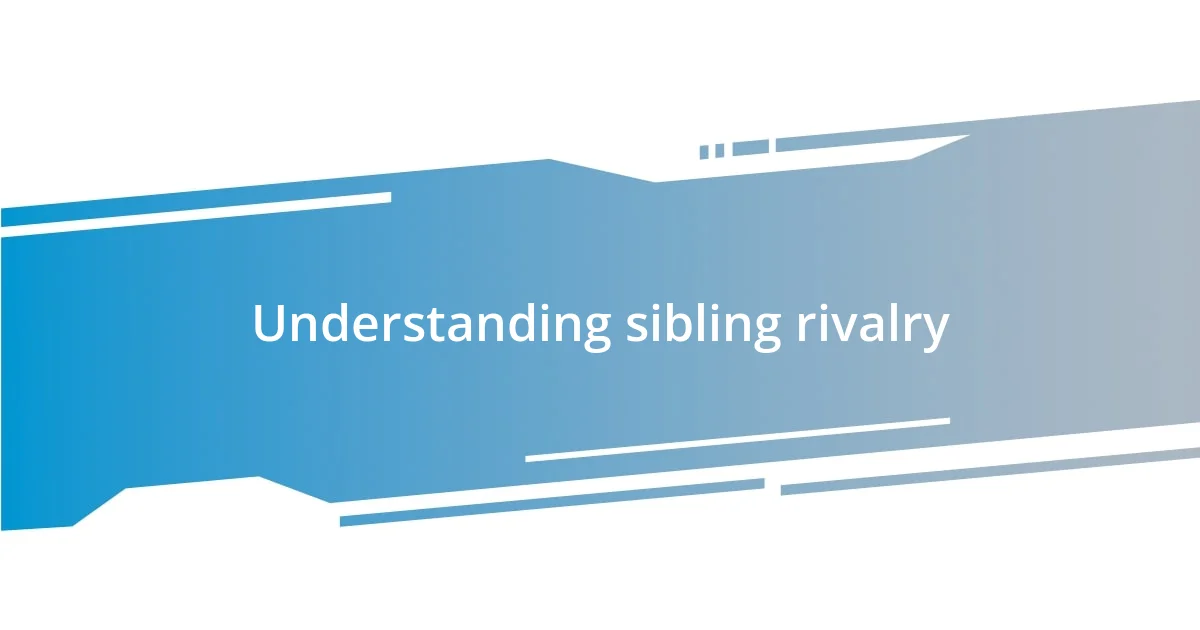Key takeaways:
- Sibling rivalry is driven by competition for limited resources, parental attention, and age differences, often revealing deeper emotional dynamics.
- Open communication, individual bonding time, and establishing boundaries can effectively manage sibling rivalry and promote cooperative relationships.
- Encouraging positive interactions through gratitude, collaborative activities, and open discussions fosters empathy and strengthens sibling bonds.

Understanding sibling rivalry
Sibling rivalry is a complex tapestry woven from love, jealousy, and competition. I remember a time when my brother and I battled it out over the TV remote. It was ridiculous, yet it felt so incredibly important at that moment. I often wondered: why did something so trivial ignite such fiery emotions?
As I’ve reflected on our experiences, it’s clear that rivalry serves as a natural part of sibling dynamics. It brings out our competitive edges, often manifesting over shared resources like toys or parental attention. One day, my sister won a spelling bee, and I couldn’t help but feel a pang of envy mixed with pride. Have you ever felt that conflicting mix of emotions? That’s the essence of sibling relationships.
Ultimately, understanding sibling rivalry requires us to recognize it as a learning opportunity. I learned empathy as I navigated my relationships with my siblings. Each argument, each playful jab, shaped our bonds in surprising ways, proving that competition could coexist with deep love and support. Isn’t it fascinating how rivalry can teach us about our strengths and weaknesses?

Causes of sibling rivalry
Sibling rivalry often springs from a mix of factors that intertwine, creating a dynamic that’s both challenging and engaging. At its core, competition for limited resources plays a significant role. I recall times when my sister and I would argue over who got to use the bathroom first in the morning. It wasn’t just about the bathroom; it was about feeling valued and prioritized.
Here are some key causes of sibling rivalry:
- Limited parental attention: Siblings may compete for the emotional and physical attention of parents.
- Resource sharing: Tangible items like toys, clothes, or even privileges can be points of contention.
- Age differences: Maturity gaps can lead to misunderstandings and resentment, as younger siblings may feel overlooked or dismissed.
- Personality clashes: Different temperaments can create friction; I often found myself clashing with my brother’s laid-back attitude when I was deeply goal-oriented.
- Perceived favoritism: When one sibling feels like they are favored over the other, it can breed jealousy and resentment.
As I look back, I realize that our little skirmishes often stemmed from these underlying issues, with emotions running high over what seemed trivial on the surface. Each quarrel, while frustrating at the time, revealed deeper feelings of love and the desire for connection.

Signs of sibling rivalry
Sibling rivalry can manifest in various signs, each often serving as a clue to deeper emotional undercurrents. I distinctly remember my younger brother sulking whenever I received praises from our parents. That sullen expression wasn’t just about jealousy; it was his way of expressing that he felt overshadowed and undervalued. Watching those subtle emotions play out taught me a lot about unspoken feelings.
Another classic sign of rivalry can surface in constant bickering or competition over everyday tasks. I found myself locked in a humorous contest with my sister over who could unpack their school backpack faster. While it felt trivial, these moments were, in reality, fueled by a desire to claim superiority in our day-to-day lives. It’s almost as if we were in a race to see who could earn the most parental applause—and this harmless competition had lasting effects on our relationship.
One of the more noticeable signs I’ve encountered is the sudden shift in behavior around personal achievements. I vividly recall when I scored well on a math test, and my brother reacted with exaggerated indifference. As an observer, I could sense the turmoil beneath his facade. Changes like these are often reflective of a sibling’s internal struggle with self-worth in relation to their sibling’s successes. Identifying these emotional cues is essential, and they remind us just how intertwined love and rivalry can be.
| Signs of Sibling Rivalry | Examples |
|---|---|
| Behavioral Changes | Withholding affection or displaying jealousy when one sibling receives attention. |
| Constant Competition | Engaging in ongoing contests over mundane tasks or achievements to seek validation. |
| Emotional Outbursts | Exaggerated reactions or indifference in response to a sibling’s successes or failures. |

Strategies for managing rivalry
To effectively manage sibling rivalry, open communication is essential. I remember sitting down with my siblings during one particularly tense phase and letting them voice their feelings without judgment. This candid discussion transformed our perspective on each other; it became clear that our bickering was often driven by unexpressed needs and emotions. How many arguments could have been avoided if we had just talked it out sooner?
Another strategy I found helpful was establishing individual time with each sibling. I made it a point to create special moments with my brother, separate from our usual group activities. During our one-on-one time, I discovered how much he enjoyed building models, a passion that often got overshadowed in our busy home. This not only strengthened our bond, but it also diminished the competition as we learned to celebrate each other’s interests.
Setting boundaries around sharing resources also proved invaluable. Instead of allowing toys or privileges to become points of contention, I introduced a system where we took turns with certain items. I remember when we first implemented a schedule for the TV remote—who knew it could turn a battlefield into a peaceful coexistence? This approach reinforced the idea that fairness didn’t mean a loss of individuality but a chance to coexist harmoniously. Why is it that sometimes, simply agreeing on boundaries can lead to such a shift in atmosphere?

Creating a cooperative environment
Creating a cooperative environment is about fostering a sense of belonging among siblings. I recall setting up a family game night where each sibling had a chance to choose a game to play. That simple act turned our competitive spirits into collaboration, igniting laughter and shared excitement as we worked together instead of against one another. As I watched my brothers cheer for each other’s successes in the game, I realized that these moments could bridge the gaps caused by rivalry.
Another effective approach is emphasizing teamwork over competition. I remember one summer afternoon when we embarked on a DIY project, restoring an old treehouse in our backyard. The task required cooperation, and seeing my siblings relying on one another’s strengths helped cultivate an atmosphere of support. After all, isn’t it amazing how working towards a common goal can shift perspectives? We traded ideas, celebrated small victories, and even shared the occasional ice cream break, reinforcing our ties and reminding us that collaboration often brings us closer.
Finally, I learned the importance of celebrating individual achievements as a family. One year, we created a “family recognition board” where each sibling could display their accomplishments—big or small—like awards, drawings, and even important schoolwork. This simple gesture created a space for acknowledgment without competition. Seeing my sister’s artwork celebrated felt just as fulfilling as my own accolades. I can’t help but wonder, how often do we overlook the power of honoring each other’s journeys in favor of competition? This recognition transformed our dynamic from rivalry to mutual support, nurturing an environment where everyone felt valued.

Encouraging positive sibling interactions
Encouraging positive sibling interactions can often be a game changer in nurturing healthy relationships. One moment that stands out for me was when my siblings and I decided to start a “gratitude jar” together. Each week, we took turns writing down things we appreciated about each other and sharing them at our family dinner. It was remarkable to see the smiles on our faces as we read those notes aloud. I think about how, in many ways, appreciating one another can reframe how we see our differences.
Another technique that became pivotal in our dynamic was creating sibling challenges that were less about competition and more about mutual fun. I remember organizing a cooking night where we paired up and whipped up our favorite meals. Instead of competing, we ended up swapping recipes and tastes, helping each other along the way. It made me realize how often we focus on who does better instead of enjoying the experience together. Have we underestimated the joy that comes from collaboration in the kitchen?
Lastly, I found that inviting open-ended discussions about our feelings led to powerful moments of connection. I once suggested that we each share a secret goal we had, whether it was personal or academic. As we opened up to each other, it created a deeper understanding of who we were as individuals, not just as siblings. It’s funny how vulnerability can pave the way for stronger bonds. Isn’t it striking how a simple conversation can illuminate the complexities of our relationships and create empathy in its wake?
















